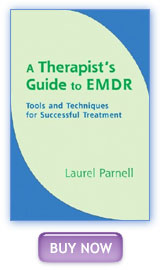Books by Dr. Laurel Parnell
A Therapist’s Guide to EMDR
Tools and Techniques for Successful Treatment
For over a decade, eye-movement desensitization and reprocessing (EMDR) has been gaining attention and momentum as an effective therapeutic tool for treating a range of trauma and phobic disorders. More and more therapists are seeking proper training to be able to incorporate EMDR into their practices. Often, therapists leave EMDR training enthusiastic, desiring to use these techniques in their practice, but then lose their nerve when encountering difficulties and treatment obstacles. Somehow, the theory learned in training is hard to translate into clinical practice.
Click here to download the flyer with mail-in order form
Read a book review from PsycCRITIQUES on “What Makes EMDR Work?”
In A Therapist’s Guide to EMDR, Parnell addresses this common dilemma by offering therapists an all-in-one, practical handbook for skillfully and successfully using EMDR in their practices. Drawing on fifteen years of experience as a pioneering EMDR clinician and trainer, Parnell expertly bridges the gap between EMDR training and actual practice by identifying and exploring the four areas where most EMDR-trained therapists need help: case formulation, ego strengthening, target development, and processing difficulties.
After a helpful refresher on basic EMDR procedure and protocol, as well as a discussion of how to modify these steps to fit your client’s needs, Parnell delves into the areas essential to successful utilization of EMDR with clients: case conceptualization; preparation for EMDR trauma processing, including resource development and installation; target development; methods for unblocking blocked processing, including the creative use of interweaves; and session closure. A step-by-step description of a typical EMDR session is also presented, including all the major procedural steps, followed by an explanation of the clinical applications of EMDR in working with phobias, traumas, and critical incidents. Case examples, vignettes, and illustrations throughout help to clarify important concepts.
Written in an immensely accessible and practical style by someone who has trained thousands of EMDR practitioners, Parnell bases the book on on-the-ground experience of doing EMDR, incorporating the tools, techniques, and tips she has generated and gathered from conferences, workshops, and consultation with colleagues, as well from her own clinical experience. Perhaps most importantly, she acknowledges the unique approaches to EMDR use that are possible, emphasizing therapist–client flexibility, attunement, and intuition, rather than rigidity of practice. For EMDR-trained therapists who would like a little help integrating EMDR into their day-to-day practice, A Therapist’s Guide to EMDR is the ideal resource.
EMDR Consultant and Trainer
Editor EMDR Casebook
EMDR Trainer and Consultant
Editor EMDR Solutions: Pathways to Healing
Author Finding the Energy to Heal
Co-author Healing the Divided Self
